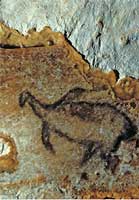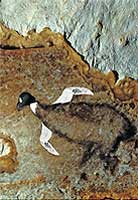 Plate 17 Plate 17
|
 Plate 18 Plate 18
|
|
spears. The Great Auk was surely known to the Paleolithic residents of the region. The 29-inch (74-centimeter) flightless bird, also known as the Northern Penguin, became extinct in its modern northern range in 1844 following several generations of ruinous overharvesting. It had been an extraordinarily effective diver, like some of its smaller relatives, like Razorbills (Alca torda) and Puffins (Fratercula arctica), that are still found in the region today. But the Great Auk could well have been called the Great Awkward for its clumsy gait on land. That feature made it easy prey for eighteenth- and nineteenth-century hunters and, much earlier, presumably for Paleolithic hunters as well. One of the clues identifying this bird are its stunted wings, which, though usually held clamped tightly to the body, were apparently held “a little out (so that light shows under it) when it began to run” (Plate 18).[34] In those colder times the auk occurred in France and the Mediterranean and probably dove within sight of the historic cave found by Cosquer.[35]
This painting not only indicates the species’ former distribution in the region but also suggests that it had special value to the artist and to the local human community. Perhaps it was also valued as food, but we know that early hunters in historic times took
page 4--> |
Plate 17 Auk in Cosquer Cave,Alpes Maritimes, France, c. 17,000-16,000 BCE. Charcoal on rock wall. © Photo: J. Clottes. In J. Clottes, J. Courtin, and L. Vanrell, Cosquer Redécouvert (Paris: Le Seuil, 2005). Science Art--Birds.
Plate 18 Modified Detail of Auk in Cosquer Cave,Alpes Maritimes, France, 2005/2007, by Darryl Wheye. © Darryl Wheye. Science Art-Birds
© 2008 Darryl Wheye and Donald Kennedy
|

 Plate 17
Plate 17  Plate 18
Plate 18